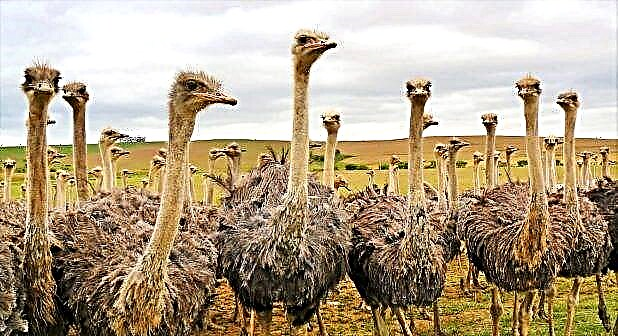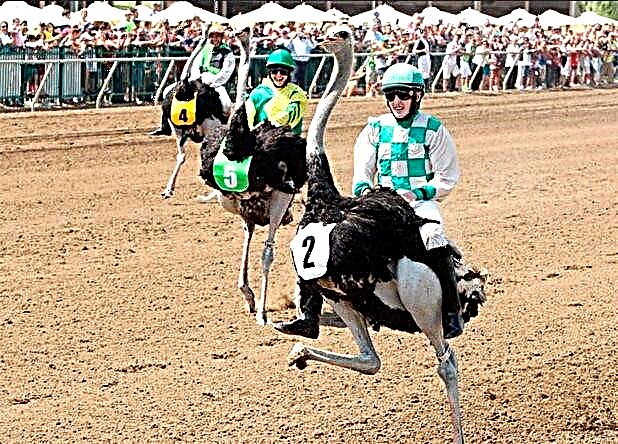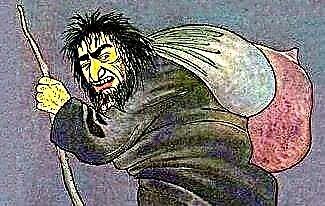The ostrich is a bird that is unique not only for its size. The main thing that people who are not particularly keen on biology know about the ostrich is that in case of danger the ostrich hides its head in the sand. The biggest bird is also the biggest misconception. Ostriches do not hide their heads, they spread their whole body along the ground so as to become as invisible as possible. The head on a long neck, respectively, is laid on the ground.
Ostriches are also, if not unique, then a very rare example of a relatively reasonable attitude of man towards an endangered animal species. People managed, without hesitation, to exterminate dozens of animal species. But when in the second half of the 19th century giant birds were on the verge of destruction, people took effective measures to preserve the ostriches. Dozens of farms were created - this turned out to be also a profitable business - and now, in the foreseeable future, the destruction of ostriches is not threatened.
Birds are very interesting and varied both in their characteristics and habits. Sometimes the ostrich can seem extremely stupid, and sometimes their behavior looks very smart. Ostriches are considered the best fathers, but in captivity, if the size of the feeders is incorrectly selected, adult ostriches may well trample young animals near them. Here are some more not-known facts and stories about ostriches and their way of life.

1. To classify ostriches is extremely simple. The bird with two toes is the African ostrich, with three is the Australian emu, and with four is the South African rhea. Formally, rhea and emu are not ostriches, but the disputes of scientists in this case are too casuistic, one has only to look at the images of ostrich, rhea and emu. The two-toed ostrich with a blue neck is Somali or South African, pink neck is a distinctive feature of Massai and Malian ostriches.
2. The question of whether the distant ancestors of ostriches flew, or not, remains controversial. The appearance seems to indicate that the details - ostriches are birds and are similar to them, first of all, by the presence of wings. However, in this case, we have to admit that ostriches evolved in the opposite direction. Their keel disappeared - a large sternum, to which the "flying" muscles of the wings are attached. The bones of the ostriches have acquired a different structure than the bones of birds. This also applies to feathers. They are similar to the feathers of other birds, but are fundamentally different from them. looseness - the grooves of the feathers do not adhere them to each other, and the feathers, thus, do not form a continuous surface of the wing. Perhaps such a zigzag of evolution is caused by the fact that the ancestors of ostriches were much larger than today's birds (there is some fossil evidence of this), and were doomed to be unable to fly by their size.
3. As you know, Australians are always unlucky with animals. Either rabbits devastate fields at a catastrophic pace, now the cat population becomes rampant, then camels that have multiplied to impossibility in search of water sweep away everything in their path, then birds and crocodiles are dying from the reed toad by millions. And in 1932, in the south-west of the continent, real military operations were unfolded against the emu. Birds that had been migrating from the central regions closer to the ocean for years suddenly found plowed fields on their way - farmers after the Great Depression dramatically increased the cultivated areas. Of course, the emus immediately forgot about migration - food and water are nearby, there are no predators. The farm fences were designed to resist rabbits, not half a quintal of birds. Farmers, who were already having a hard time due to falling prices, sounded the alarm and turned to the Minister of Defense for help. "Pay for the bullets!" - replied the minister, and allocated machine guns. The first attack on a flock of 20,000 birds disgracefully failed - because of the rain the ostriches scattered over a vast territory, making machine-gun fire ineffective. They tried to chase the birds on a truck, lured them into ambushes, tried to lie in wait near the watering hole - in vain. Having shot 2,500 cartridges, the soldiers managed to kill from 50 to 200 birds, some ornithologists even say about 12 dead ostriches. The military reported to the command about 500 defeated opponents and the absence of their own losses. The minister of defense reported to parliament, and after the regrouping of forces, the ostriches were dealt a second blow. This time, people who received combat experience (according to their reports) acted more efficiently and, having shot 10,000 cartridges, killed 1,000 and wounded 2,500 birds. Only after such a defeat did the parliament stop this circus and simply announced a prize for each head of an ostrich. In 1934, over 57,000 awards were paid.
4. Ostriches can be mounted in the same way as horses. Of course, it will not be possible to catch the first ostrich that comes across, saddle it and make a horse ride. The ostrich is a bird strong enough to be wayward. Nevertheless, ostriches are very trainable and even participate in races. Professional jockeys have been competing in ostrich races since the second half of the 19th century. In the US state of Florida, ostrich racing is considered one of the most popular sports. Ostrich races are also held in the states of Iowa, Minnesota, California, Nevada, Louisiana, Arizona and Michigan. In Europe, the most popular ostrich races are held in Holland. Ostriches compete both under saddle and in chariots.

5. Ostriches in general, as biological species, were saved by their unpretentiousness and ability to breed in captivity. When the first ostrich farms were established in South Africa and the United States in the 1880s, these birds were on the verge of complete destruction. They were shot by the thousands in order to obtain beautiful feathers. When they began to breed ostriches in captivity, it turned out that excellent feathers can be obtained by simply cutting them off a three-year-old male without any harm to his health. How many millions of ostriches were killed so that European fashionistas and women of fashion could decorate their toilets with ostrich feathers, we will never know. Whole hunting expeditions were organized for ostrich feathers. No wonder - hats decorated with ostrich feathers were worn by all more or less wealthy women in large cities. In London, an ostrich feather at the end of the 19th century could have cost as much as £ 5, the two weeks' wages of a not-so-skilled worker. Ostrich feathers ranked fourth in exports from the Union of South Africa, right after diamonds, gold and wool. The business ended abruptly in 1914 - with the outbreak of the First World War, women's fashion became practical before asceticism, and elaborate jewelry such as feathers became irrelevant.
6. There is still limited demand for ostrich feathers. True, now flightless birds are not killed. Feathers from the first row in the bird's wing are carefully cut a few millimeters from the skin. Feathers with symmetrical coloration are especially appreciated. They are used in arts and crafts to create various compositions and installations, as well as to decorate clothes and accessories. And, of course, artificial feathers are used more often.
7. In Russia, in 1882, Baron Friedrich Falz-Fein began to breed ostriches in captivity. In his famous estate Askania-Nova, located in the Azov region, Falz-Fein settled several Malian ostriches. The Baron was not going to extract profit from the ostriches, he was interested in the possibilities of adaptation of various exotic animals and birds in Russia. In the case of ostriches, the experiment was successful. Together with other inhabitants of Askania-Nova, African birds survived all political and military cataclysms, and they live in the reserve to this day. It was possible to see an ostrich within the Russian Empire before. At least as early as 1874, the Moscow Telegraph newspaper published an advertisement urging Muscovites to look at the largest bird in the world, capable of swallowing large stones and even iron. The ticket cost 25 kopecks.
8. Ostriches have a very small brain and, as a result, a very weak memory. Any new experience, especially in captivity, causes severe stress in ostriches. Even a change in diet can become such an impression. It takes a long time for birds to "digest" any change in their environment. The staff of the ostrich farms wear the same type of clothing that birds are accustomed to. You can move ostriches to another territory no earlier than a month before the start of mating, otherwise the season will be lost. At the same time, ostriches have a very strong herd instinct - if, frightened, one bird runs somewhere, the rest will rush after it, not making out the road. This could cause injury to birds. The taming of ostriches is not their training - the birds simply get used to a new pattern of required actions. On their own, ostriches cannot even figure out that in a room with a low ceiling it is impossible to sharply unbend the neck, so the aviaries on farms are made three meters high. If an ostrich sticks its head into a mesh of wire mesh, it can break its neck trying to straighten it rather than pulling its head back.
9. The efficiency of the ostrich in terms of its breeding is close to 100%. Only a part of the feathers go to clean waste, a few, light, like all birds, bones, a small part of the entrails, head and paws. Feathers are used for jewelry, skin is valued almost as much as snake, and meat is similar in consistency and taste to beef.
10. Newly hatched ostriches from eggs can weigh up to a kilogram and grow 20 centimeters. In the first few months of life, they grow at a rate of 1 cm in 24 hours, until they reach the growth limit of 160 - 180 cm. Young ostriches are gaining marketable weight already at 10 months.

11. Breeding ostriches is several times more effective than raising cattle. From the time of fertilization of the cow until the calf reaches marketable weight, 650 days pass, the weight of the meat obtained will be 250 kg. For about the same period, a female ostrich will give about 50 heads of offspring. This is about 2 tons of meat and 50 m2 skin. The cost of keeping birds is paid for only by selling the skin, the rest goes to profit. Moreover, the reproductive period of a female ostrich lasts up to 40 years.
12. Ostrich meat, even in comparison with beef, broiler meat and turkey meat, contains less cholesterol, less calories, contains less fat and more protein. In terms of cholesterol content, trout meat gives more or less similar indicators.
13. Ostrich eggs can weigh from 500 to 1,800 grams, although there are record holders of much greater weight. Only unfertilized eggs are eaten. As a rule, these are eggs that are laid at the beginning or end of the season, or obtained from females laying for the first time. The cost of ostrich eggs depends on the time of year and the region, but buying an egg for less than 500 rubles is a lot of luck. In terms of composition, an ostrich egg with an accuracy of tenths of a percent repeats the composition of a chicken egg, but in terms of volume it can replace 25-40 chicken eggs. It will take at least an hour and a half to cook a hard-boiled ostrich egg.
14. On the loose, ostriches live in rather complex communities. The ostriches themselves live in families consisting of a male, several females, one of which is dominant, and young animals. Dozens of such families can live on good pastures or at watering places in a relatively small area. In addition, large herds of herbivores - antelopes, zebras, etc., often graze next to ostriches. Ostriches have excellent eyesight - of course, their eyes weigh more in total than their brains - and herbivores have a good sense of smell. This symbiosis allows you to know about the approach of predators in advance. In addition, various animal trifles - reptiles, amphibians, rodents - which are disturbed by the herd, serves as an excellent complementary food for ostriches.
15. Ostriches can be excellent shepherds. In Africa, farmers have adapted to graze ostriches alongside sheep. In such a symbiosis, as a rule, neither predators nor people poke around. And in South America, rhea not only guard herds of hundreds of geese, but also independently “escort” them to the pasture and back to the corral.









